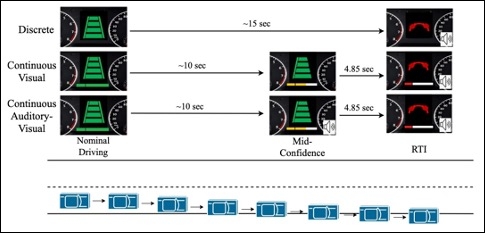WTS Iowa Student Spotlight
The WTS Iowa "Student Spotlight" series features great transportation-related research from students all over Iowa. Learn about their work and stay up-to-date on the latest industry research.
Emily Shull graduated from The University of Iowa with a Bachelor of Arts degree in Psychology in 2018. In her last semester, she
started a position as a research assistant at the National Advanced Driving Simulator (NADS). Going into it, she wasn't exactly sure how psychology related to the transportation field, but she quickly realized that psychology plays a major role in driver behavior, including attention, situation awareness, trust, and overall individual differences among drivers.
Soon after beginning, her supervisor, Dr. John Gaspar, gave her a relatively open-ended research proposal funded by SAFER-SIM. Emily used the proposal to create an experimental design examining partially automated driving and how informing the user of the automation's confidence (i.e., automation's current capability) via the human-machine interface (HMI) can influence takeover performance when the automation fails unexpectedly. She created an HMI display that included a 'confidence bar', similar to a bar displaying battery level, which ranged from full and green (fully confident/capable), to less full and yellow ("mid-confidence"), and finally, at the minimum level and red indicating a request to intervene. Emily then compared this continuous group to a control group that did not have a confidence bar nor a "mid-confidence" alert.

Emily was fortunate to lead this study and gained experience in study design, scenario development, HMI design, data collection and protocol, reducing and analyzing data, and finally, reporting results in an article that will soon be submitted to the Journal of Cognitive Engineering and Decision Making.
In January of 2020, she began working toward her PhD in the Industrial and Systems Engineering program at the University of Iowa. “As someone with very little engineering experience at the time, I was hesitant to jump right in but fortunately realized very quickly that my psychology background gave me a unique perspective in a room full of engineers. As many engineers focus on the process of perfecting a technology or product, I was much more focused on designing for the human user as they are the ones using it.”
Emily was recently awarded a grant by SAFER-SIM as a continuation of the first study she led. This study will further examine the gap effect in automated driving. If you are not familiar, the gap effect says that in order to redirect your attention to a point of interest, you must first disengage your attention from the current focal point. It further suggests that attention can be disengaged quicker if the current focal point is removed prior to the appearance of the new focal point. To apply this to a driving scenario where the participant is playing a game of trivia on a tablet, she plans to turn off the trivia screen just before the takeover request appears to evaluate whether the removal of the focal point can facilitate the redirection of attention.
Additionally, the NADS was recently awarded a $1.45 million grant by NHTSA to investigate a sufficient window of time that is needed for a user to re-engage cognitively and physically with the driving task when the automation is no longer able to perform safely. In other words, how long does the user need between the time they are notified they will need to takeover and the time a takeover is required. As a student with strong interests in the cognitive processes needed to re-engage in the driving task, Emily will have a significant role in the development and analysis of this 2-year project while also incorporating her own interests to further her research as she continues her PhD.